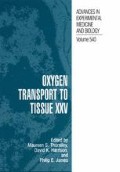Abstract
Hemodilution is widely used in various fields of clinical medicine such as vascular and cardiac surgery, orthopedics, etc. Replacing whole blood with a crystalloid fluid reduces blood viscosity, improves cerebral blood flow and enhances oxygen delivery to tissue, minimizing disturbances at the microcirculatory levell,2. Brain tissue possesses powerful regulatory mechanisms to maintain O2 delivery, and for the undamaged circulation an adequate oxygen supply can be sustained even during severe anemia3−5. Oxygen supply to tissue may be impeded at profound levels of hemodilution, because the compensatory hyperemic response may be exhausted at low levels of arterial oxygen capacity6. Few studies, however, have focused on the effect of anemia on oxygenation at the level of brain microvessels, where most of the oxygen exchange between blood and tissue takes place7−9.
Access this chapter
Tax calculation will be finalised at checkout
Purchases are for personal use only
Preview
Unable to display preview. Download preview PDF.
References
L.F. Duebener, T. Sakamoto, S. Hatsuoka, C. Stamm, D. Zurakowski, B. Vollmar, M.D. Menger, H.J. Schaf-ers, and R.A. Jonas, Effects of hematocrit on cerebral microcirculation and tissue oxygenation during deep hypothermic bypass, Circulation 104 (12 Suppl 1): 1260–1264 (2001).
R. Chan, E. Leniger-Follert, Effect of isovolemic hemodilution on oxygen supply and electrocorticogram in cat brain during focal ischemia and in normal tissue, Int. J. Microcirc. Clin. Exp. 2 (4), 297–313 (1983).
R. Bauer, T. Iijima, and K.A. Hossmann, Influence of severe hemodilution on brain function and brain oxidative metabolism in the cat, Intensive Care Med. 22 (1), 47–51 (1996).
A.G. Hudetz, J.D. Wood, B.B. Biswal, I. Krolo, and J.P. Kampine, Effect of hemodilution on RBC velocity, supply rate, and hematocrit in the cerebral capillary network. J. Appl. Physiol. 87 (2), 505–509 (1999).
Y. Morimoto, M. Mathru, J.F. Martinez-Tica, and M.H. Zornow, Effects of profound anemia on brain tissue oxygen tension, carbon dioxide tension, and pH in rabbits. J Neurosurg. Anesthesiol. 13 (1), 33–39 (2001).
M. Watanabe, N. Harada, H. Kosaka, and T. Shiga, Intravital microreflectometry of individual pial vessels and capillary region of rat. J. Cereb. Blood Flow Metab. 14 (1), 75–84 (1994).
J. van Bommel, A. Trouwborst, L. Schwarte, M. Siegemund, C. Ince, and Ch. P. Henny, Intestinal and cerebral oxygenation during severe isovolemic hemodilution and subsequent hyperoxic ventilation in a pig model, Anesthesiology 97 (3), 660–70 (2002).
E.P. Vovenko, Distribution of oxygen tension on the surface of arterioles, capillaries and venules of brain cortex and in tissue in normoxia: an experimental study on rats, Pflügers Arch. 437 (4), 617–623 (1999).
L. Zheng, A.S. Golub, and R.N. Pittman, Determination of PO2 and its heterogeneity in single capillaries, Am. J. Physiol. 271 (1), H365 - H372 (1996).
C.M. Rovainen, D.B. Wang, and T.A. Woolsey, Strobe epi-illumination of fluorescent beads indicates similar velocities and wall shear rates in brain arterioles of newborn and adult mice, Microvasc. Res. 43 (2), 235–239 (1992).
A.G. Hudetz, Regulation of oxygen supply in the cerebral circulation, Adv. Exp. Med. Biol. 428, 513–520 (1997).
Author information
Authors and Affiliations
Editor information
Editors and Affiliations
Rights and permissions
Copyright information
© 2003 Springer Science+Business Media New York
About this paper
Cite this paper
Vovenko, E., Golub, A., Pittman, R. (2003). Microvascular PO2 and Blood Velocity Measurements in Rat Brain Cortex During Hemodilution with a Plasma Expander (Hespan) and a Hemoglobin-Based Oxygen Carrier (DCLHb). In: Thorniley, M., Harrison, D.K., James, P.E. (eds) Oxygen Transport to Tissue XXV. Advances in Experimental Medicine and Biology, vol 540. Springer, Boston, MA. https://doi.org/10.1007/978-1-4757-6125-2_30
Download citation
DOI: https://doi.org/10.1007/978-1-4757-6125-2_30
Publisher Name: Springer, Boston, MA
Print ISBN: 978-1-4419-3428-4
Online ISBN: 978-1-4757-6125-2
eBook Packages: Springer Book Archive

